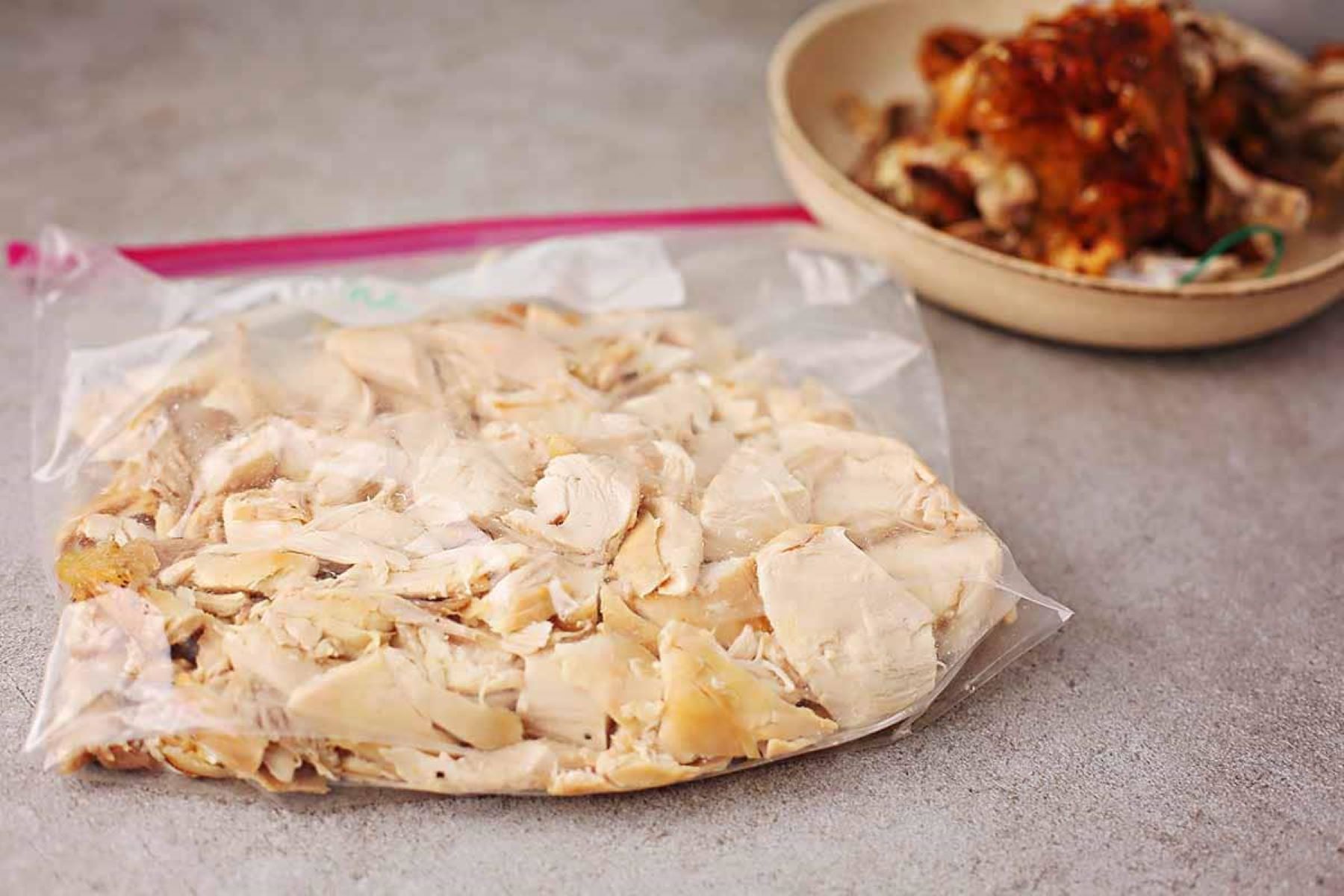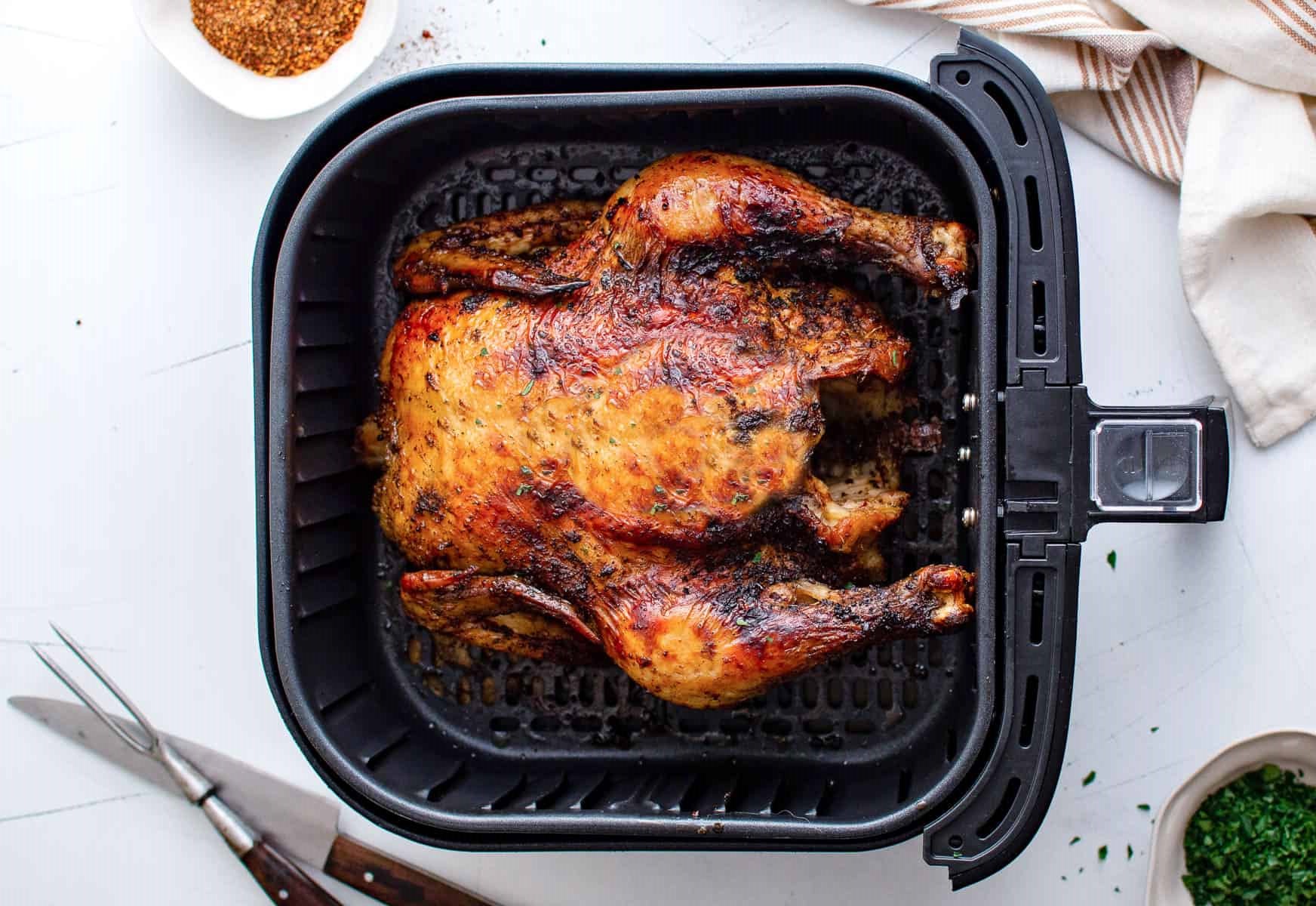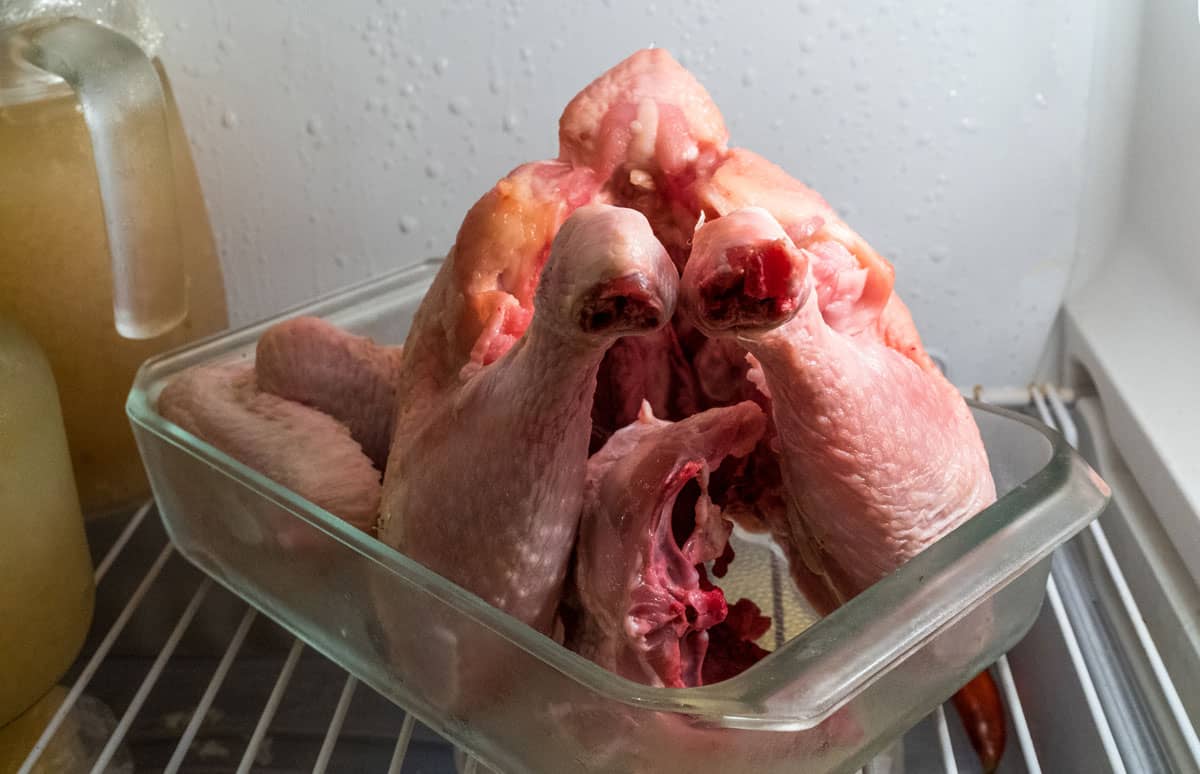

Articles
How To Store Rotisserie Chicken In Freezer
Modified: January 7, 2024
Learn how to properly store rotisserie chicken in the freezer to keep it fresh and delicious. Our informative articles provide step-by-step instructions for maximizing the shelf life of your cooked chicken.
(Many of the links in this article redirect to a specific reviewed product. Your purchase of these products through affiliate links helps to generate commission for Storables.com, at no extra cost. Learn more)
Introduction
Rotisserie chicken is a delicious and convenient meal option for many people. Whether you purchase it from a grocery store or make it yourself, having leftover rotisserie chicken can be quite common. Instead of letting it go to waste, why not store it in the freezer for future use?
Storing rotisserie chicken in the freezer comes with a host of benefits. Not only does it allow you to extend the shelf life of the chicken, but it also provides you with a ready-to-eat meal option whenever you’re in a pinch. It’s a great way to save time and money, as you can buy rotisserie chicken in bulk when it’s on sale and store it for later use.
To ensure that your frozen rotisserie chicken retains its flavor, texture, and quality, it’s important to follow the proper methods of preparation and storage. In this article, we will walk you through step-by-step instructions on how to store rotisserie chicken in the freezer successfully.
Before we delve into the details, it’s essential to note that properly storing rotisserie chicken in the freezer is crucial for maintaining food safety. By following the recommended guidelines and practices, you can enjoy your frozen rotisserie chicken without any worries.
So, let’s get started and learn how to store rotisserie chicken in the freezer to ensure maximum freshness and taste!
Key Takeaways:
- Freezing rotisserie chicken extends its shelf life, reduces food waste, and provides convenient, cost-effective meal options for busy days. Proper preparation and packaging are essential for maintaining flavor and quality.
- Thaw and reheat frozen rotisserie chicken safely to enjoy delicious, protein-packed meals. Follow proper storage techniques, utilize quality packaging, and label packages with freezing dates for optimal freshness.
Benefits of Storing Rotisserie Chicken in the Freezer
Storing rotisserie chicken in the freezer offers several benefits, making it a smart choice for anyone looking to preserve their leftover chicken. Here are some advantages of freezing rotisserie chicken:
- Extended Shelf Life: One of the key benefits of freezing rotisserie chicken is that it extends its shelf life. Instead of relying on the short-term refrigeration, freezing allows you to preserve the chicken for several months. This means you can enjoy the delicious flavors of rotisserie chicken long after it’s been cooked.
- Convenient Meal Option: By freezing rotisserie chicken, you’re essentially creating a ready-to-eat meal option for those times when you’re short on time or simply don’t feel like cooking. Having pre-cooked rotisserie chicken stored in the freezer ensures that you always have a quick and convenient protein source available for salads, sandwiches, soups, stir-fries, and more.
- Cuts Down Food Waste: According to statistics, a significant amount of food is wasted each year. By freezing rotisserie chicken, you can play your part in reducing food waste. Instead of letting the leftover chicken go bad and end up in the trash, freezing it allows you to use it at a later date when you’re ready to enjoy a delicious meal.
- Cost Savings: Buying rotisserie chicken in bulk when it’s on sale and freezing the leftovers can result in significant cost savings. Instead of purchasing smaller quantities of chicken each time you need it, you can take advantage of bulk discounts and freeze the excess portions. This way, you’ll always have a supply of tasty rotisserie chicken without breaking the bank.
- Diverse Meal Options: Frozen rotisserie chicken can be used in a wide variety of recipes. From pasta dishes and casseroles to wraps and tacos, the possibilities are endless. By having frozen rotisserie chicken on hand, you can easily transform it into a delicious and satisfying meal by adding a few ingredients and spices.
As you can see, freezing rotisserie chicken offers several benefits that make it a practical and economical choice. Whether you’re looking to extend its shelf life, have a convenient meal option, or cut down on food waste, storing rotisserie chicken in the freezer is a smart decision.
Preparing the Rotisserie Chicken for Freezing
Before you freeze your leftover rotisserie chicken, it’s important to properly prepare it to ensure maximum freshness and quality. Here are the steps to follow:
- Cooling: Allow the rotisserie chicken to cool down completely before freezing it. This will prevent condensation and ice crystals from forming on the chicken, which can affect its texture and flavor.
- Remove Bones and Skin (optional): If desired, you can remove the bones and skin from the rotisserie chicken before freezing. This can help save space in your freezer and make it easier to portion out the chicken when you’re ready to use it. However, leaving the bones and skin intact can help preserve the moisture and flavor of the chicken.
- Portioning: Divide the rotisserie chicken into individual or family-sized portions based on your needs. This will allow you to thaw and use only the amount you require, rather than having to thaw the entire chicken at once.
- Remove Excess Moisture: Pat the chicken pieces dry with paper towels to remove any excess moisture. This step is crucial to prevent ice crystals from forming on the chicken during freezing.
By following these steps, you can ensure that your rotisserie chicken is well-prepared for freezing. It’s important to note that while these steps contribute to the overall quality of the frozen chicken, they are optional. You can choose to freeze the chicken as is, without removing bones or skin, if you prefer.
Next, let’s explore the different packaging options available for freezing rotisserie chicken to keep it fresh and maintain its flavor.
Packaging Options for Freezing Rotisserie Chicken
When it comes to packaging rotisserie chicken for freezing, it’s essential to choose the right materials to maintain its freshness and prevent freezer burn. Here are some packaging options to consider:
- Plastic Freezer Bags: Plastic freezer bags are a popular choice for storing rotisserie chicken. Look for bags specifically designed for freezer use, as they are thicker and more durable. Place the cooled and portioned chicken into the bags, squeeze out as much air as possible, and seal them tightly. Label the bags with the date of freezing to keep track of freshness.
- Airtight Containers: Airtight containers, such as Tupperware or glass containers with airtight lids, are also a good option for freezing rotisserie chicken. Make sure the containers are freezer-safe and leave some headspace to accommodate any expansion that may occur during freezing. Like freezer bags, label the containers with the freezing date.
- Freezer Wrap: If you prefer a traditional approach, you can use freezer wrap to package your rotisserie chicken. Wrap each portion tightly with freezer paper or aluminum foil to protect it from air and moisture. To further ensure a tight seal, place the wrapped chicken in a plastic freezer bag or airtight container.
Regardless of the packaging option you choose, it’s important to remove as much air as possible to minimize the chances of freezer burn. Freezer burn occurs when food is exposed to air, causing dryness and loss of quality.
Remember to label each package with the date of freezing, as well as any additional information you find necessary. This will help you keep track of the freshness of the frozen rotisserie chicken, allowing you to use the oldest portions first.
Now that we’ve covered the packaging options, let’s move on to the step-by-step process of freezing rotisserie chicken.
Step-by-Step Guide to Freezing Rotisserie Chicken
Freezing rotisserie chicken is a straightforward process that can be done in a few simple steps. Here is a step-by-step guide to help you freeze your leftover rotisserie chicken:
- Cool the Chicken: Allow the rotisserie chicken to cool completely before freezing. This will prevent condensation and ice crystals from forming on the chicken.
- Prepare the Chicken: Remove the bones and skin from the chicken if desired, or leave them intact. Cut the chicken into individual or family-sized portions based on your needs.
- Package for Freezing: Choose a packaging option such as plastic freezer bags, airtight containers, or freezer wrap. Place the cooled and portioned chicken into the packaging, ensuring that it is sealed tightly and any excess air is removed. Label the packages with the date of freezing.
- Organize in the Freezer: Arrange the packaged chicken in a single layer in the freezer initially to facilitate faster freezing. Once frozen, you can stack the packages to save space.
- Set the Freezer Temperature: Ensure that your freezer is set to 0°F (-18°C) or below. This temperature will keep the chicken frozen safely.
- Keep Track of Date: Remember to label each package with the date of freezing. This will help you keep track of the freshness of the chicken so that you use the oldest portions first.
Following these steps will help you properly freeze your rotisserie chicken and maintain its quality for an extended period. Remember to store the chicken in the coldest part of your freezer to maintain its freshness.
Now that your rotisserie chicken is safely stored in the freezer, let’s explore some helpful tips for ensuring proper storage.
After purchasing a rotisserie chicken, allow it to cool to room temperature before placing it in an airtight container or freezer bag. Label with the date and store in the freezer for up to 3 months.
Read more: How To Store Costco Rotisserie Chicken
Tips for Properly Storing Rotisserie Chicken in the Freezer
Properly storing rotisserie chicken in the freezer is essential to maintain its flavor, texture, and quality. Here are some helpful tips to ensure that your frozen rotisserie chicken stays in optimal condition:
- Use Quality Packaging: Choose high-quality packaging materials that are specifically designed for freezer use. This will help prevent freezer burn and maintain the taste and texture of the chicken.
- Remove Excess Air: When packaging the chicken, make sure to remove as much air as possible to minimize the chances of freezer burn. Air exposure can lead to loss of flavor and moisture in the chicken.
- Label and Date: Clearly label each package with the date of freezing. This will help you keep track of the freshness of the chicken so that you can use the oldest portions first. It’s also helpful to include any additional information, such as the portion size or any seasonings used.
- Store Properly: Place the packaged rotisserie chicken in the coldest part of your freezer, such as the back or bottom shelf. This will ensure that the chicken remains at a consistently low temperature, preventing any potential temperature fluctuations.
- Do Not Refreeze: Once you have thawed and used the frozen rotisserie chicken, it’s important not to refreeze it. Refreezing can lead to a decrease in quality and increase the risk of foodborne illnesses. Instead, use the thawed chicken within a couple of days.
- Rotate the Stock: To prevent freezer burn and maintain the quality of the frozen rotisserie chicken, consider implementing a rotation system. Use the oldest portions first and regularly rotate the stock to ensure that you’re always consuming the chicken within its recommended storage time.
- Follow Proper Thawing Techniques: When you’re ready to use the frozen rotisserie chicken, make sure to thaw it safely. The best way to thaw the chicken is by transferring it from the freezer to the refrigerator and allowing it to thaw overnight. This slow and controlled thawing process ensures that the chicken retains its moisture and quality.
By following these tips, you can ensure that your rotisserie chicken remains delicious and enjoyable even after being frozen. Proper packaging, labeling, and storage practices are key to maintaining the quality and safety of the frozen chicken.
Now, let’s explore the process of thawing and reheating frozen rotisserie chicken.
Thawing and Reheating Frozen Rotisserie Chicken
When it comes to thawing and reheating frozen rotisserie chicken, it’s important to follow proper techniques to ensure food safety and preserve the taste and texture. Here’s a step-by-step guide:
- Thawing: The best way to thaw frozen rotisserie chicken is by transferring it from the freezer to the refrigerator and allowing it to thaw overnight. This slow thawing process ensures that the chicken thaws evenly and safely. Make sure to place the chicken in a leak-proof container or on a plate to prevent any potential leakage onto other foods in the refrigerator.
- Reheating Options: There are several methods you can use to reheat thawed rotisserie chicken, depending on your preference and time constraints:
- Oven: Preheat your oven to 350°F (175°C). Place the chicken pieces on a baking sheet and cover them loosely with foil to prevent drying out. Reheat for 15-20 minutes or until the internal temperature reaches 165°F (74°C).
- Microwave: Place the chicken pieces on a microwave-safe plate and cover with a microwave-safe lid or microwave-safe wrap. Microwave on medium power in short intervals, checking and stirring the chicken between intervals, until it reaches the desired temperature.
- Stovetop: Heat a skillet or frying pan over medium heat. Add a small amount of oil or butter to prevent sticking. Place the chicken pieces in the pan and cook for a few minutes on each side until heated through.
- Grill: Preheat your grill to medium heat. Brush the chicken pieces with a marinade or oil to prevent sticking. Grill for a few minutes on each side until heated through and grill marks appear.
- Checking the Internal Temperature: To ensure that the reheated rotisserie chicken is safe to eat, use a meat thermometer to check the internal temperature. The chicken should reach a minimum temperature of 165°F (74°C) to kill any harmful bacteria.
- Serving and Enjoying: Once the rotisserie chicken is fully reheated, you can serve it immediately. Enjoy it as is or incorporate it into your favorite recipes, such as salads, sandwiches, wraps, or stir-fries.
By following these steps, you can safely thaw and reheat your frozen rotisserie chicken, ensuring that it is not only delicious but also safe to consume.
Now, let’s address some frequently asked questions about storing rotisserie chicken in the freezer to provide you with more insights.
Frequently Asked Questions (FAQs)
Here are some common questions and answers regarding the storage and freezing of rotisserie chicken:
Q: How long can I store rotisserie chicken in the freezer?
A: When stored properly in airtight packaging, rotisserie chicken can be kept in the freezer for up to 4 months. However, for the best quality and taste, it is recommended to consume it within 2-3 months.
Q: Can I freeze a whole rotisserie chicken?
A: Yes, you can freeze a whole rotisserie chicken by wrapping it tightly in foil or freezer wrap. However, keep in mind that it will take longer to thaw and reheat compared to individual portions.
Q: Can I freeze rotisserie chicken that has been previously frozen?
A: It is not recommended to refreeze rotisserie chicken that has already been thawed and reheated. Refreezing can affect the quality and safety of the chicken.
Q: Can I freeze the leftover chicken juice or gravy from the rotisserie chicken?
A: While it is possible to freeze the leftover chicken juice or gravy, it is recommended to store them separate from the chicken itself. This allows you more flexibility in using the chicken and the sauce separately.
Q: Can I freeze rotisserie chicken in its original packaging?
A: It is best to transfer the rotisserie chicken to airtight packaging before freezing. The original packaging may not be designed for long-term freezing and may not provide adequate protection against freezer burn.
Q: Can I freeze rotisserie chicken that has already been seasoned or flavored?
A: Yes, you can freeze rotisserie chicken that has been seasoned or flavored. The seasonings and flavors will infuse into the chicken during the freezing and thawing process, enhancing its taste.
Q: Can I freeze the bones from the rotisserie chicken for making stock?
A: Absolutely! You can freeze the leftover bones from the rotisserie chicken to use for making stock or broth later on. Just make sure to wrap and store them separately from the chicken meat.
These are just a few of the common questions related to storing rotisserie chicken in the freezer. If you have any more specific inquiries or concerns, it’s always best to consult reliable food safety resources or reach out to a professional.
Now, let’s wrap up the article.
Conclusion
Storing rotisserie chicken in the freezer is a practical and convenient way to extend its shelf life and have ready-to-eat meals on hand. By following the proper preparation and packaging techniques, you can ensure that your frozen rotisserie chicken retains its flavor, texture, and quality.
Some of the key benefits of freezing rotisserie chicken include extending its shelf life, providing a convenient meal option, reducing food waste, saving money, and offering a wide range of meal possibilities. Freezing allows you to make the most of your leftover chicken and enjoy it in various recipes whenever you need a quick and protein-packed meal.
Remember to properly cool the chicken before freezing, remove excess moisture, and choose the appropriate packaging option such as plastic freezer bags, airtight containers, or freezer wrap. Label each package with the date of freezing to keep track of its freshness.
Thaw the frozen rotisserie chicken safely in the refrigerator and reheating options include the oven, microwave, stovetop, or even grilling. Ensure that the chicken reaches a minimum internal temperature of 165°F (74°C) to ensure food safety.
By implementing these tips and following the suggested guidelines, you can make the most of your rotisserie chicken leftovers and enjoy delicious meals even on busy days.
So, the next time you have leftover rotisserie chicken, don’t let it go to waste. Freeze it properly and have a convenient and tasty meal option available whenever you need it!
Frequently Asked Questions about How To Store Rotisserie Chicken In Freezer
Was this page helpful?
At Storables.com, we guarantee accurate and reliable information. Our content, validated by Expert Board Contributors, is crafted following stringent Editorial Policies. We're committed to providing you with well-researched, expert-backed insights for all your informational needs.















0 thoughts on “How To Store Rotisserie Chicken In Freezer”